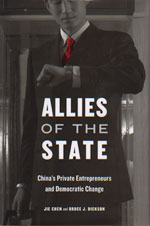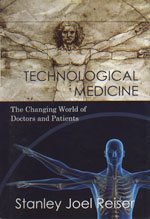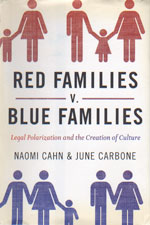Chinese Checkers
 If we build it, they will come. At least, that's been the conventional wisdom for U.S. policy toward China: If we help build prosperity in the Communist state, a new class of influential citizens will begin pushing for democracy.
If we build it, they will come. At least, that's been the conventional wisdom for U.S. policy toward China: If we help build prosperity in the Communist state, a new class of influential citizens will begin pushing for democracy.
But "that may be an overly optimistic assumption," says Bruce Dickson, a professor of political science and international affairs at GW.
His new book, Allies of the State (Harvard University Press, 2010), co-written with Jie Chen, a professor of Chinese politics at Old Dominion University, digs into data from the authors' representative survey of more than 2,000 private entrepreneurs. It is the broadest study to date that gauges their level of interest in democratization.
An influential theory in U.S. foreign policy holds that development and modernization—such as shifting from an agricultural economy to an urban, industrial one—helps propel a state toward democracy, Dr. Dickson says. That would seem to apply to China, where the count of private enterprises has grown by 35 percent annually since the early 1990s and created some 44 million urban jobs between 2002 and 2006 alone.
But that theory frays under data suggesting China has been successfully drawing these capitalists into the government's sphere of influence (for example, through government-sponsored business associations) and keeping them relatively content, placating a broad swath of businessmen through both continued corruption and incremental reforms that foster economic growth.
For now it seems to be working, he says.
The study yields important considerations for understanding China, the authors write, but also the rise and political futures of other emerging countries.
Between Doctors and Patients
 In an era of high-tech marvels that come and go as swiftly as rush-hour subway trains, it seems unfathomable that in the early 1800s a doctor's primary tools for diagnosis were nearly the same as they had been for the ancient Greeks: the word of the patient and superficial observation.
In an era of high-tech marvels that come and go as swiftly as rush-hour subway trains, it seems unfathomable that in the early 1800s a doctor's primary tools for diagnosis were nearly the same as they had been for the ancient Greeks: the word of the patient and superficial observation.
It was the invention of the humble stethoscope, in 1816, that set the practice of medicine on its ear (literally) and forever altered the way doctors and patients interact.
The implications of the device—born out of a French doctor's need to listen to the sounds of a female patient's chest while minding her modesty—are weighed in Technological Medicine (Cambridge University Press, 2009), written by physician Stanley Joel Reiser, a clinical professor of health care sciences and health policy at GW.
The book nimbly traces the history of medical technology and efforts to navigate the benefits and costs brought by each advance. "For as we create technology and strive to apply its powers, it recreates us," Dr. Reiser writes. In chapters chock-full of interesting tidbits, he delves into key stops along the way, like the X-ray, the electronic medical record, and the rise of scientific testing that eventually would be applied to therapies like bloodletting, which he notes was "the longest continually used therapy in Western medicine."
Still, Dr. Reiser meditates on the need for doctors to look beyond the narrow view of technology to treat the whole patient: to reclaim some of the personal attention that has slipped away since the stethoscope first came between a doctor and a patient.
A More Purple Union
 If you look very closely at the color-coded map of U.S. politics (you've really got to squint), you're likely to find the "red" states have lots of tiny "red" families and the "blue" states lots of "blue" ones. But what do those divisions mean, and how did we get here?
If you look very closely at the color-coded map of U.S. politics (you've really got to squint), you're likely to find the "red" states have lots of tiny "red" families and the "blue" states lots of "blue" ones. But what do those divisions mean, and how did we get here?
The questions fuel a new book by family law experts Naomi Cahn, the John Theodore Fey Research Professor of Law at GW Law School, and June Carbone, a professor at University of Missouri-Kansas City School of Law. In Red Families v. Blue Families: Legal Polarization and the Creation of Culture (Oxford University Press, 2010) they explore the make-up of these two very general models.
The "blue family" model stresses college education, pushing back family-building until financial and emotional maturity, gender neutral family roles, and openness to sexual preference and sex education. For "red families," the expectation is abstinence until marriage, then childbirth; marriage is at a younger age and is a crucial tie to local communities built on foundations of more traditional values and family roles. The "red" model, says professor Cahn, is "a far better system in an economy where, with a high school education, you can get a good job."
The "blue families," she says, have adapted to the changing times while the "red" system feels "under attack from these new values," and is beset by realities that fall short of its virtues. "Red" areas have higher teen pregnancy rates, more shotgun weddings, and a younger average age at marriage, all of which (as well as lower income) are more likely to lead to divorce.
That's not to say the "blue" model has it all figured out. The teen birth rate is lower, but it's aided by more available abortions. And the pursuit of education and stability can come at the price of waiting too long to start a family.
By disentangling local needs from national political party rhetoric, the authors write, states can be free to legislate more effectively.
"We hope that readers take away that there's a need to try to move away from some of these fights," says professor Cahn, "and to look at the actual impact … of how these debates over family values play out in real people's lives."
—Danny Freedman
